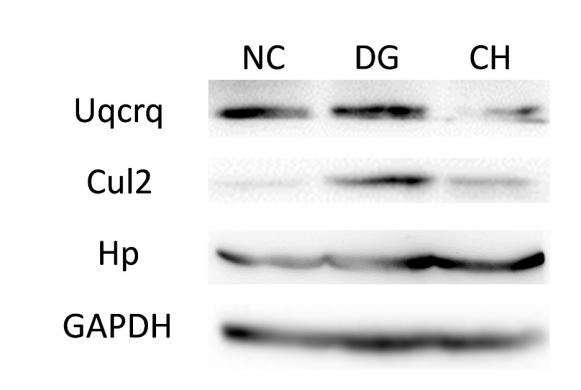HP Antibody - #DF6467
| Product: | HP Antibody |
| Catalog: | DF6467 |
| Description: | Rabbit polyclonal antibody to HP |
| Application: | WB IHC IF/ICC |
| Cited expt.: | WB, IF/ICC |
| Reactivity: | Human, Mouse, Rat |
| Prediction: | Pig, Rabbit, Dog |
| Mol.Wt.: | 42kDa; 45kD(Calculated). |
| Uniprot: | P00738 |
| RRID: | AB_2838429 |
Related Downloads
Protocols
Product Info
*The optimal dilutions should be determined by the end user. For optimal experimental results, antibody reuse is not recommended.
*Tips:
WB: For western blot detection of denatured protein samples. IHC: For immunohistochemical detection of paraffin sections (IHC-p) or frozen sections (IHC-f) of tissue samples. IF/ICC: For immunofluorescence detection of cell samples. ELISA(peptide): For ELISA detection of antigenic peptide.
Cite Format: Affinity Biosciences Cat# DF6467, RRID:AB_2838429.
Fold/Unfold
Binding peptide; BP; Haptoglobin alpha chain; Haptoglobin alpha(1S) beta; Haptoglobin alpha(2FS) beta; Haptoglobin beta chain; Haptoglobin, alpha polypeptide; Haptoglobin, beta polypeptide; HP; HP2 ALPHA2; HP2ALPHA2; HPA1S; HPT; HPT_HUMAN; MGC111141; Zonulin;
Immunogens
A synthesized peptide derived from human HP, corresponding to a region within the internal amino acids.
- P00738 HPT_HUMAN:
- Protein BLAST With
- NCBI/
- ExPASy/
- Uniprot
MSALGAVIALLLWGQLFAVDSGNDVTDIADDGCPKPPEIAHGYVEHSVRYQCKNYYKLRTEGDGVYTLNDKKQWINKAVGDKLPECEADDGCPKPPEIAHGYVEHSVRYQCKNYYKLRTEGDGVYTLNNEKQWINKAVGDKLPECEAVCGKPKNPANPVQRILGGHLDAKGSFPWQAKMVSHHNLTTGATLINEQWLLTTAKNLFLNHSENATAKDIAPTLTLYVGKKQLVEIEKVVLHPNYSQVDIGLIKLKQKVSVNERVMPICLPSKDYAEVGRVGYVSGWGRNANFKFTDHLKYVMLPVADQDQCIRHYEGSTVPEKKTPKSPVGVQPILNEHTFCAGMSKYQEDTCYGDAGSAFAVHDLEEDTWYATGILSFDKSCAVAEYGVYVKVTSIQDWVQKTIAEN
Predictions
Score>80(red) has high confidence and is suggested to be used for WB detection. *The prediction model is mainly based on the alignment of immunogen sequences, the results are for reference only, not as the basis of quality assurance.
High(score>80) Medium(80>score>50) Low(score<50) No confidence
Research Backgrounds
As a result of hemolysis, hemoglobin is found to accumulate in the kidney and is secreted in the urine. Haptoglobin captures, and combines with free plasma hemoglobin to allow hepatic recycling of heme iron and to prevent kidney damage. Haptoglobin also acts as an antioxidant, has antibacterial activity, and plays a role in modulating many aspects of the acute phase response. Hemoglobin/haptoglobin complexes are rapidly cleared by the macrophage CD163 scavenger receptor expressed on the surface of liver Kupfer cells through an endocytic lysosomal degradation pathway.
The uncleaved form of allele alpha-2 (2-2), known as zonulin, plays a role in intestinal permeability, allowing intercellular tight junction disassembly, and controlling the equilibrium between tolerance and immunity to non-self antigens.
Secreted.
Expressed by the liver and secreted in plasma.
Belongs to the peptidase S1 family.
References
Application: IF/ICC Species: Mouse Sample:
Application: WB Species: mice Sample: Liver tissues
Restrictive clause
Affinity Biosciences tests all products strictly. Citations are provided as a resource for additional applications that have not been validated by Affinity Biosciences. Please choose the appropriate format for each application and consult Materials and Methods sections for additional details about the use of any product in these publications.
For Research Use Only.
Not for use in diagnostic or therapeutic procedures. Not for resale. Not for distribution without written consent. Affinity Biosciences will not be held responsible for patent infringement or other violations that may occur with the use of our products. Affinity Biosciences, Affinity Biosciences Logo and all other trademarks are the property of Affinity Biosciences LTD.


